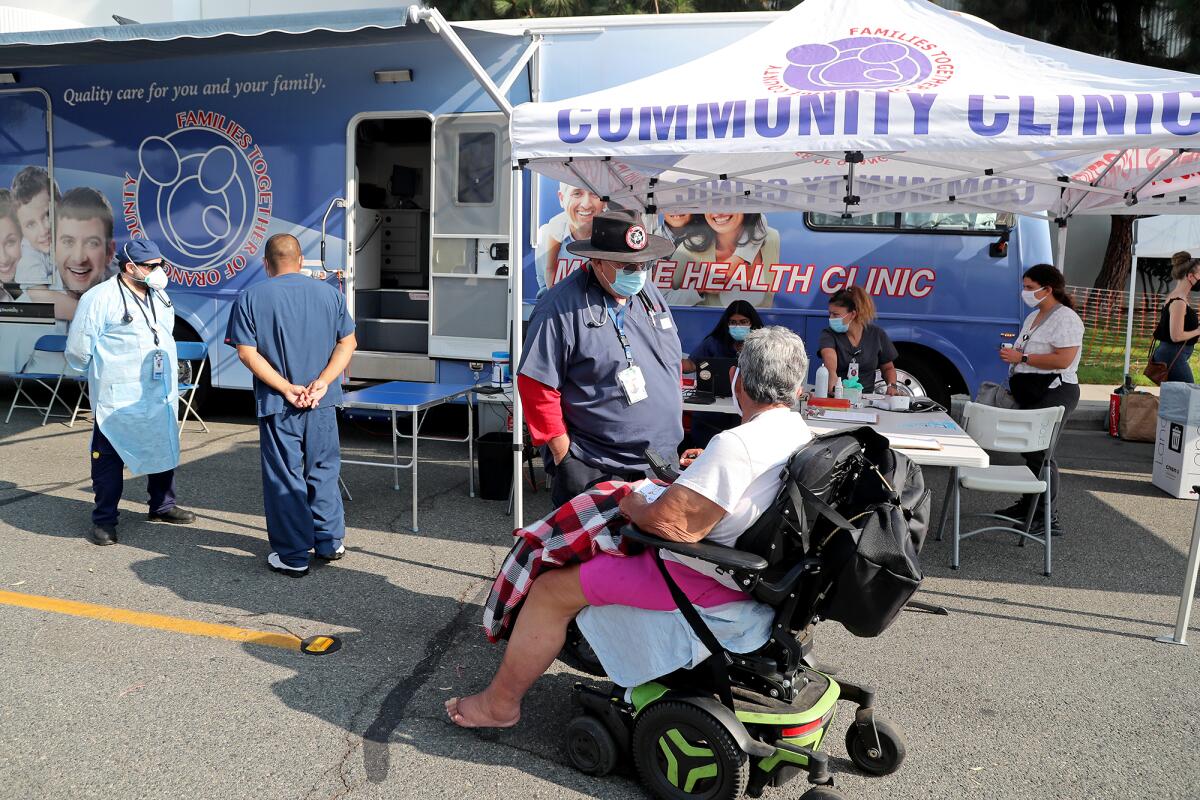Orange County COVID-19 hospitalizations ease, spurring hope for end of Omicron peak

- Share via
Countywide COVID-19 hospitalizations saw another welcome decrease for the second consecutive day, a possible indication the Omicron variant-fueled surge may be slowing, according to data released Friday by the Orange County Health Care Agency.
The number of hospitalized patients also fell, from 1,183 Thursday to 1,144, while the number of patients in intensive care declined from 199 to 188.
However, the percentage of available ICU beds countywide dropped from 19.4% Thursday to just 17.5%, below the 20% threshold at which health experts become concerned, while the number of available ventilators stood at 60.6%.
Of those hospitalized, 85% are unvaccinated, while 87% of ICU patients are not inoculated. The last time county hospitalizations were this high was February 2021, when there were 1,164 COVID-19 patients on Feb. 5.
Andrew Noymer, an epidemiologist and UC Irvine professor of population health and disease prevention, told City News Service Friday the data shows “continued improvement, and we may have turned the corner.”
Still, Noymer added, “It’s a little tricky to call it for sure, but it looks like we’ve found a peak, but COVID is littered with premature congratulations.”
Orange County’s adjusted daily case rate per 100,000 residents dipped from 200 Thursday to 197.1 Friday. The testing positivity rate also inched down, from 27.4% to 26.5% among the at-large population, and from 31.5% to 29.5% in the health equity quartile, which measures underserved communities hardest hit by the pandemic.
The county reported 11,020 new positive COVID-19 tests Friday, raising the cumulative total to 477,127. The county logged seven more fatalities, upping the death toll so far to 5,953.
January’s death toll so far stands at 22, compared to 78 deaths recorded in December and 104 in November. Those figures mark a steady decline from September, when 196 individuals died from COVID-19, according to county figures.
Earlier this month, the county reported that a third child under the age of 5 had died in December over COVID-19 complications in Orange County.
In contrast, the death toll before the Delta variant fueled a summer surge was 31 in July, with 19 in June, 26 in May, 47 in April, 202 in March and 620 deaths recorded in February. January 2021 remains the deadliest month of the pandemic in Orange County, with a death toll of 1,598, ahead of December 2020, the next deadliest, with 985 lives lost to the virus.
One the seven reported dead on Friday was an assisted living facility resident, raising the death toll since the pandemic began in that category to 648. So far, 1,225 skilled nursing facility residents countywide have died.
Meanwhile, outbreaks — defined as three or more infected residents — dropped from 42 elderly assisted living facilities last week to 37 as of Tuesday, and from 30 to 29 for skilled nursing facilities.
County officials are coordinating staffing assistance and distributing COVID-19 tests at area assisted living and skilled nursing facilities, according to Orange County Chief Health Officer Dr. Clayton Chau. A strict testing regimen helps residents and staff assess a facility’s risk, so operators can keep visiting hours open.
“It’s not good for [residents’] mental health” to not be able to visit with relatives, Chau said at a news conference Tuesday.
In California, many people trying to visit their loved ones in nursing homes and other care facilities are struggling to get timely COVID test results.
Due to widespread staffing shortages in the healthcare industry, state officials are allowing some infected healthcare workers to report to work if they are asymptomatic and are working with infected patients, Chau added.
Orange County jails have also been managing the recent surge in infections. As of Friday, 349 infected inmates had been reported, up from 275 Wednesday. Of those infected, 79 had been newly booked into facilities.
Orange County Board of Supervisors Chairman Doug Chaffee implored residents to get vaccinated, pointing out the vast majority of COVID-19 hospital patients are unvaccinated.
“That’s stressing the whole system,” Chaffee said Tuesday. “People who have other medical needs won’t get the care they need because the hospital is filled with unvaccinated patients. If we work together, we’ll win this COVID battle and make 2022 a successful and prosperous year.”
The number of fully vaccinated residents in Orange County as of Thursday stood at 2,372,444. That number included an increase from 2,205,067 last week to 2,219,206 of residents who have received the two-dose regimen of vaccines from Pfizer or Moderna.
The number of residents receiving the one-dose Johnson & Johnson vaccine also increased, from 152,694 to 153,238. Booster shots increased from 975,937 to 1,043,267.
“I am pleased to hear that,” Noymer said Friday.
The number of vaccinated children aged 5 to 11 increased this week from 52,803 to 57,435, compared to the 211,145 who remain unvaccinated and account for the least vaccinated age group in Orange County. The next-least vaccinated age group is 25 to 34, with 316,763 inoculated and 142,638 who have still not gotten a shot.
The infection rate per 100,000 unvaccinated residents decreased from 355.9 on Jan. 8 to 234.1 on Jan. 15, the most recent data available. For those fully vaccinated who’ve not received a booster shot, the infection rate dropped from 275.5 to 162.1. For the fully vaccinated and boosted, the rate dropped from 114.8 to 73.5.
All the latest on Orange County from Orange County.
Get our free TimesOC newsletter.
You may occasionally receive promotional content from the Daily Pilot.





